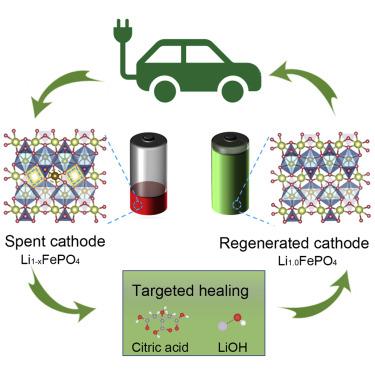Joule ( IF 39.8 ) Pub Date : 2020-11-12 , DOI: 10.1016/j.joule.2020.10.008 Panpan Xu , Qiang Dai , Hongpeng Gao , Haodong Liu , Minghao Zhang , Mingqian Li , Yan Chen , Ke An , Ying Shirley Meng , Ping Liu , Yanran Li , Jeffrey S. Spangenberger , Linda Gaines , Jun Lu , Zheng Chen

|
Recycling of spent lithium-ion batteries (LIBs) is an urgent need to address their environmental and global sustainability issues. Here, we report an efficient and environmentally benign LIB regeneration method based on defect-targeted healing, which represents a paradigm-shift LIB recycling strategy. Specifically, by combining low-temperature aqueous solution relithiation and rapid post-annealing, we demonstrate successful direct regeneration of spent LiFePO4 (LFP) cathodes, one of the most important materials for EVs and grid storage applications. We show revitalization of composition, structure, and electrochemical performance of LFP with various degradation conditions to the same levels as the pristine LFP. Life-cycle analysis of different LIB recycling processes shows that this defect-targeted direct reycling approach can significantly reduce energy usage and greenhouse gas (GHG) emissions, leading to more economic and environmental benefits compared with today’s hydrometallurgical and pyrometallurgical methods.
中文翻译:

通过有针对性的修复有效地直接回收锂离子电池阴极
回收废旧锂离子电池(LIB)是解决其环境和全球可持续性问题的迫切需求。在这里,我们报告了一种基于缺陷针对性修复的有效且环境友好的LIB再生方法,该方法代表了范式转移LIB回收策略。具体而言,通过结合低温水溶液再结晶和快速后退火,我们证明了废LiFePO 4的成功直接再生(LFP)阴极,是电动汽车和电网存储应用中最重要的材料之一。我们展示了LFP的组成,结构和电化学性能的振兴,具有与原始LFP相同水平的各种降解条件。对不同的LIB回收过程进行生命周期分析表明,这种针对缺陷的直接灰化方法可以显着减少能源使用量和温室气体(GHG)排放,与当今的湿法冶金和火法冶金方法相比,可以获得更多的经济和环境效益。



























 京公网安备 11010802027423号
京公网安备 11010802027423号